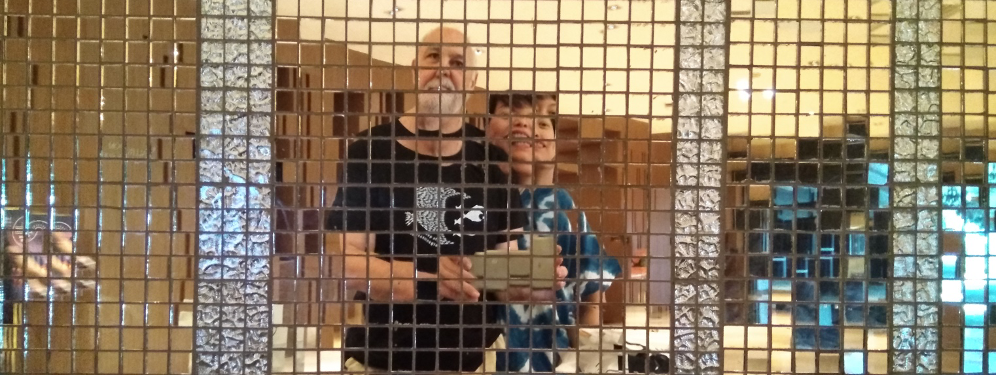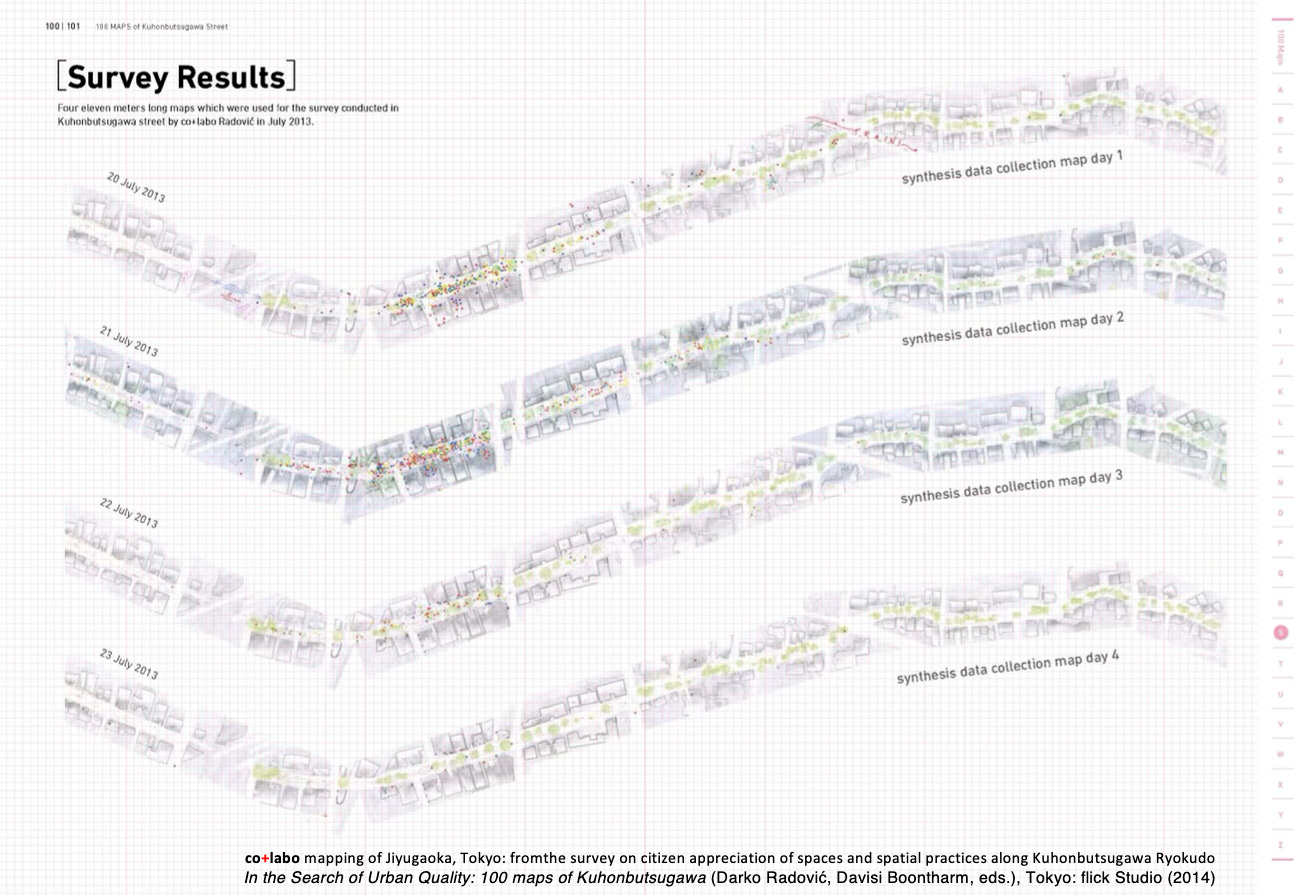008 ON SUBJECTIVITY – and how to include it in urban research and practice
from "Subjectivities in Investigations of the Urban" (segment 4)
In order to conquer everyday life, and diminish individual human potentials and collective urge to meagre instrumentalised consumerism. The Spectacle reduces experiential depth of our existence, by favouring flattened images over profound realities. It favours nuclear individualism, which detrimentally affects the urban, as the most profound spatial projection of social essence of human being.
Our existences, as we are going to see, are profoundly relational. Everything about us is au pluriel, and thus about the relationships between various, and variously interacting subjectivities. In urban research and production of space, that means simultaneous singularities of all actors involved. In architectural design, subjectivity is accepted and even supported only when it is about artistic, and thus highly exclusive dimensions of space. That, to a certain degree, extends to urban design, confining it to the same mould of exclusivity. Further from the exclusive realms of design, towards what should be inclusive processes of (urban) planning and research, subjectivity – as it can not be easily controlled, gets strictly proscribed.
The urban can never be subjected to any single knowledge or power, despite all the efforts to do so. There were never true “owners” nor true “authors” of any proper city. “A private city” would be an oxymoron. Cities are always layered realities which, at all lavels, include multiple, entangled subjectivities. The synthetic flux of those realities, the actual urban fabric, its real places and times, is always as much accidental as it is the product of careful planning and development strategy. That is due to the immense complexity it embodies. The reason why the Spectacle so desperately seeks to flatten and simplify urban realities is in order to control the urban. That is also one of the reasons of perpetual urban crisis. All efforts towards flattening stay pitifully unsuccessful.
As Guy Debord came to recognise, “the essentially personal nature of the relationship between the individual and the city, sensing that this subjective realm was always going to remain at odds with the objective mechanisms of the psycho-geographical methodology that sought to expose it, 'The secrets of the city are, at a certain level, decipherable,’ wrote Debord, 'But the personal meaning they have for us is incommunicable.' “ (Coverley, 2006). Dialectics between the decipherable and the incommunicable in the urban is precisely where the key argument of the book is placed.
Such epistemological frameworks are never “pure”, as there are no “pure” realities in the urban. Correspondingly complex methods also need to be “impure”. From such impurities often emerge those missing, incommunicable qualities. In their “impurity”, these frameworks tend to have complex and composite foundations, as in Lefebvre’s or Jean-Luc Nancy’s intellectual lineages. In the case of the letter, for instance, inspirations are marked by thinkers as different and (in this sense) as (in)congruent as Rousseau, Marx, Freud, Heidegger, Husserl and Lacan. In urbanism, in a comparatively complex way, there is no overarching, successful theory but always – theories, plural. Those theories tend to be fueled by the power of singular thinking, which lets itself be layered over and below all other attempts at thinking and making the urban. As Derrida reminds, “scientific theories are described as commensurable if one can compare them to determine which is more accurate; if theories are incommensurable, there is no way in which one can compare them to each other in order to determine which is more accurate” (Derrida, 2005; my italics). Accuracy is often not at stake here; preferred might be blurs or, as we are going to see later – the knots.
In the context of this approach to the urban, as for Jean-Luc Nancy, singularity “is not individuality; it is, each time, the punctuality of ‘with’ that establishes a certain origin of meaning and connects to an infinity of other possible origins … The togetherness of singulars is singularity ‘itself’” (Nancy, 2000), which means, in a way, that the very complexity of inter-subjective is the smallest unit of culture! We need to remind the reader here that Greek term for an individual – defined as a private person, one not taking part in public affairs, was – idiotes (which later, via Rome and Mediaeval appropriations acquired its contemporary meanings and which, today, in a quite convincing way, could be linked with the idea of a perfect consumer of the Spectacle.
That is so because in a human and humane world, “being” is communication (ibid.), as our being is un pluriel d’existence. The worst punishment a man can inflict of the other is solitary confinement, a worst nightmare - an deserted island.
Our existential urge is to create strings of meanings and bring some order into realities that we live. That is how we create places, building them as meanings, which take various physical forms (or the other way round), as in Heidegger, on whose shoulders Nancy wants to stand. Or, in shortest (not as a summary of Jean-Luc Nancy, as his thought could never be summarised. Nancy, at best, can only be accurately quoted), “the plurality of being is at the foundation of Being.” (ibid.; original italics). Beyond that “unit” of being, “‘with’ is the sharing of time-space; it is the at-the-same-time-in-the-same-place as itself, in itself, shattered. It is the instance scaling back to the principle of identity …” (ibid.). Cities are the embodiments of human need for coexistence, with others of our own ilk and with the radical Other (including that within our own selves).
As in Debord, whom Nancy has read and interpreted carefully, urban quality evades us as “the co- of copresence is the unpresentable par excellence, but it is nothing other then … presentation, the existence which co-appears.” (ibid.). The unpresentable, that ultimate quality, matches Debordean incommunicable.
A devout anti-Cartesian, Maurice Merleau-Ponty wrote: “My perception is [therefore] not a sum of visual, tactile and audible givens: I perceive in a total way with my whole being, which speaks to my all senses at once” (Pallasmaa, 2005, my italics). That brings us back to Spengler, Lefebvre, de Certeau and others from the opening pages of this text. When they speak about totality of the urban, they speak about an ultimate complexity. That is not the complexity of extraordinary places and moments, but that of everyday life, of Barthesian rien (Barthes, 1982), the banal “nothing” which, albeit unpresentable and incommunicable, in Bachelard’s terms, makes the “polyphony of the senses” (Bachelard, 1996). Much of our being with is immersed into, and defined by that polyphony of our making.
Ordinary, banal, quotidian qualities (perhaps, surprisingly for some) are the ultimate complexity of cities. Everyday life and the Spectacle, are irreconcilable opposites, one being the world of rich singular plural identities, and the other the world of self-sufficient individualities (or, if one prefers Greek, of idiotes).
Urban design of the kind we advocate here is not only the practice of thinking and acting (with)in the urban, but also a particular sensibility and an ability to reach into the human(e) core of cities. We are speaking about multiplied, layered subjectivities in research and design in which, rather than flattened, we want to keep each and every singularity of the participants identifiable and relational. The resulting palimpsest may not be simple. It indeed is immoderate (de Certeau), unpresentable (Derrida), incommunicable (Debord), non-measurable (Mn’M), as each scratch, every line or trace of the brush on it matters, or – it could matter.
If there is something to bring in from René Descartes here, that would be his emphasis on the importance of doubt. Nancy, addressing the issue of (self)confidence, speaks about ”us, we who are supposed to say we as if we know what we are saying and who we are talking about” (ibid). That directly opposes the flatness and simplicity of Spectacle, the epitome of which could be found in any of the overtly self-conscious, but shallow exponents of venture-financing, that flagship of neo-liberal, spectacular culture. Doubt always was, and it remains at the source of knowledge. Here - not only of our cerebral knowledge, but also of our variously suppressed, subliminal knowledges, which all would, ideally, add up to an impossible and ideal, total knowledge.
Those diverse knowledges are exactly what have been spaced out from urban research and action, since the neo-liberal globalisation took over. What we have lost is an awareness that “all of the being is in touch with all of being …” (Nancy, 2000) or, shorter, we have lost our own humanity.








